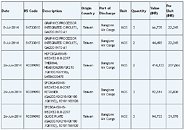Friday, July 11th 2014

NVIDIA Moving Around the Fabled GeForce GTX TITAN II
NVIDIA is moving around engineering samples of what it describes as "GM200 A1 graphics processor," in its shipping manifest. The sample was making its way from Taiwan, to Bangalore, India, from where it's likely pushed to the company's facilities in Bangalore and Hyderabad. A1 steppings of NVIDIA chips are usually pre-production, and bound for just a few more rounds of testing, before being upgraded to "A2" and mass-produced. German tech site 3DCenter.org also pulled out some likely specifications from its sources.
To begin with, the GM200, like the GM204, will be built on existing 28 nm silicon fabrication process, as both NVIDIA and AMD appear to have suffered design setbacks due to their common foundry partner, TSMC, not being able to set its next-gen 20 nm node up to speed in time. The GM200 is expected to feature over 4,000 CUDA cores, although the exact number is unknown. It is expected to widen the memory bus to 512-bit. Given the existing process, the GPU will be huge. Over 600 mm² huge. NVIDIA will probably bank on the energy efficiency of its "Maxwell" architecture to cope with thermal loads put out by a chip that big. The GM200-based "GeForce GTX TITAN II" could launch in the first half of 2015.
Source:
3DCenter.org
To begin with, the GM200, like the GM204, will be built on existing 28 nm silicon fabrication process, as both NVIDIA and AMD appear to have suffered design setbacks due to their common foundry partner, TSMC, not being able to set its next-gen 20 nm node up to speed in time. The GM200 is expected to feature over 4,000 CUDA cores, although the exact number is unknown. It is expected to widen the memory bus to 512-bit. Given the existing process, the GPU will be huge. Over 600 mm² huge. NVIDIA will probably bank on the energy efficiency of its "Maxwell" architecture to cope with thermal loads put out by a chip that big. The GM200-based "GeForce GTX TITAN II" could launch in the first half of 2015.

61 Comments on NVIDIA Moving Around the Fabled GeForce GTX TITAN II
The original titanIC was build on an earlier version of the lithography process, so yields should have been improved by now which means the production costs are much much lower without those insane margins which they put atop.
If they really set it at that price tag, then I do not want to know who are those who will give them what they ask.
Be very careful because this policy leads to a disaster - ever growing prices, so at some point virtually no one will be able to buy, only they will buy it from themselves. :laugh: ahahaha
Its not really about production cost at all, if that was what prices of products where based on we would be paying SOOOOO much less for everything.
The "at some point virtually no one will be able to buy" does not go here as Nvidia (and AMD) have a wide range of cards and many all of those will be much more affordable.
Titan is like Intel's 1000+ dollar Extreme series.
There is a slim chance all the very early rumours are wrong though and GM204 is not 880. After all, GK104 was GTX680 because Nvidia knew they could make it the top tier part. GK100 was canned. Compare with GF100/110 and GF104. Kepler was 'out of order' (in both manufacturing and price!)
Perhaps GM204 is mainstream, GM200 is 880. And they can make more money off a compute GM200 part with more memory. After all, GK110 is the Titan, 780, 780Ti and Titan Black architecture. GM200 doesn't mean Titan alone.
I think the next arch's from Nvidia and AMD should allow the 4k gaming on a single card to be a reality though, albeit, just and no more.
BTW: Even if the GM200 scales just 1mm larger on a side than GK 110 ( 600mm^2 vs 551mm^2), that still equates to a loss of 20% in the number of die candidates per 300mm wafer compared to GK 110If the big GPU sales to desktop buyers impacted the overall revenue stream to any large degree then I'd agree. While the volume mid/small GPU cards tend to get regular price adjustments, the same isn't usually the case for the high end low volume market (for either vendor I might add). That in itself should be an indicator.576mm^2 equates to 24 * 24. 600mm^2 equates to 24.49 * 24.49. More of an issue when you map them out on a wafer- those half-millimetres add up. BTW: GT200 isn't the largest GPU by a long shot. The original Larrabee was estimated at ~650-700mm^2, and even the in-production Xeon Phi GPU is estimated to be not much smaller. Intel aren't shy about specifications in general- there isn't an Intel CPU that hasn't had its die size publicized. I'd challenge anyone to find the die size and transistor count specification of a Xeon Phi GPU.
If only everyone could learn that lesson...we'd have another GTX 460 era on us. Powerful and affordable GPUs which scale wonderfully with SLI.
I may buy NV GPUs more often than AMD, but times like this I root for AMD. NV is getting away with it and they know they can. Course AMD isn't helping things. They pull the same tricks.
BTW: The Xeon Phi review in the db - it leads to a CPU review !?!
Its still so far off it does not matter at this point beyond a first glimpse if this turns out to be it. I mean in all honesty 2015 is a good while off and this has a vague first half estimate which can always change. I just hope this time around they release the 880 first instead of trying to push the Titan off on people then release the X80 model.
GTX 480 Fermi counterpart goes to Kepler N/A Never existed.
GTX Fermi Refresh GTX 580 counterpart goes to Kepler refresh GTX 780Ti.
Not confuzzled enough? Then I will throw this in too. The GTX 880 is NOT A HIGH END MAXWELL. It's a half assed attempt at a upper midrange GPU hampered by a throwback to the 28 nm process for the price of a high end GPU most likely. It might perform better than the GK110 but it's not the Flagship.